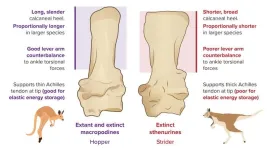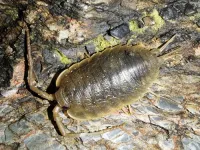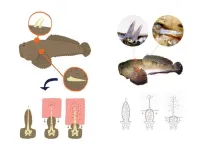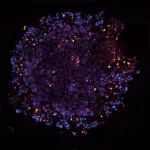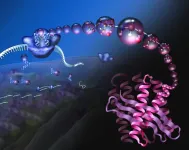(Press-News.org) Extinct kangaroos used alternative methods to their famous hop according to comprehensive analysis from University of Bristol and the University of Uppsala scientists.
Although hopping is regarded as a pinnacle of kangaroo evolution, the researchers highlight that other kinds of large kangaroos, in the not too distant past, likely moved in different ways such as striding on two legs or traversing on all fours.
In the review, published in Alcheringa: An Australasian Journal of Palaeontology, the team shows that there are other ways to be an evolutionary successful large kangaroo and that large-bodied kangaroo weren’t only specialised in endurance-hopping.
The review is an extensive discussion of the fossil evidence of the locomotion of kangaroos and their relatives (including wallabies, tree-kangaroos, rat-kangaroos, etc.) over the last 25 million years, and presents new analyses of limb bone and ankle bone metric data that add weight to previous locomotor hypotheses.
Together they indicated that the higher speed-endurance hopping, typical of modern large-bodied kangaroos, was probably rare or absent in all but a few large-bodied lineages, including the direct ancestors of modern large kangaroos like red and grey kangaroos. However, the diversity of kangaroo gaits disappeared with the Late Pleistocene extinctions of larger animals (in Australia as well as on other continents).
While almost all kangaroos today, small and large, use hopping gaits to some extent, the fossil record reveals that the locomotory capabilities of some extinct kangaroos were comparatively diverse.
The earliest recognized late Oligocene–middle Miocene (25 to 15 million years ago) basal types of kangaroos most likely employed quadrupedal bounding, climbing and slower speed hopping as their primary modes of locomotion. (All kangaroos today use quadrupedal locomotion at slow speeds, which manifests as pentapedal locomotion – using the tail as a fifth limb – in larger species.) Yet, all these early forms were small-bodied, below 12kg, with larger bodied kangaroos over 20kg not appearing until the late Miocene (around 10 million years ago), coinciding with increasing aridity and the spread of openly vegetated habitats.
Hopping is functionally problematic at larger body sizes. Consequently, some members of the later kangaroo radiation achieved a more specialized anatomy for efficient higher-speed hopping at body sizes over 35kg. Modern large kangaroos are spectacular hoppers but none today are over 100kg (most individuals under 70 kg) and many extinct forms were well above this size and physically too big to hop.
Lead author Professor Christine Janis from Bristol’s School of Earth Sciences said: “We want people to appreciate that large kangaroos were much more diverse as recently as 50 thousand years ago, which may also mean that the habitat in Australia then was rather different from today.
“In fact, modern large hopping kangaroos are the exception in kangaroo evolution.”
While hopping apparently originated early in kangaroo evolution, in small-bodied forms, with the emergence of larger-sized kangaroos in the late Miocene there were several different options: to become more specialized for large-bodied endurance hopping, as in the ancestors of modern kangaroos, or to adopt other forms of locomotion at higher speeds, as in two main extinct lineages. The protemnodons (so-called ‘giant wallabies’, closely related to modern large kangaroos) likely relied upon a more quadrupedal type of locomotion most of the time, and rarely hopped. The sthenurine short-faced kangaroos, a lineage that split from all modern kangaroos around 15 million years ago, apparently adopted bipedal striding at all speeds.
The new data presented on the length of the tibia (shin bone) and calcaneum (ankle bone) reinforce these earlier hypotheses of locomotor differences from modern kangaroos in these two extinct groups. Co-author Adrian O’Driscoll, a former Master's student in the Palaeobiology program at Bristol and now a PhD student at the University of York made this contribution. He explained: “Especially supported by this new data is the notion of bipedal striding rather than hopping in the sthenurines, as their calcanea lack the anatomy (a long calcaneal heel) that would help resist rotational forces at the ankle experienced during hopping, and suggests a more-erect limb posture rather than the crouched posture essential for hopping."
Professor Janis concluded: “The assumption that increasing continent-wide aridity after the end of the Miocene selectively favoured hopping kangaroos is overly simplistic. Hopping is only one of many gait modes employed by kangaroos both in the past and today, and the fast endurance hopping of modern kangaroos should not be regarded as some “evolutionary pinnacle’.
“What makes modern endurance-hopping kangaroos appear so unusual is the geologically recent extinction of similar animals who moved in different ways.
“We are perhaps then in need of a rival Australian airline that covers shorter distances than QANTAS and boasts a novel motif of a striding sthenurine!”
Paper:
‘Myth of the QANTAS leap: perspectives on the evolution of kangaroo locomotion’ by Christine Janis, Adrian O’Driscoll and Ben Kear in Alcheringa: An Australasian Journal of Palaeontology.
END
Skipping evolution: some kangaroos didn’t hop, scientists explain
2023-06-14
ELSE PRESS RELEASES FROM THIS DATE:
Light pollution confuses coastal woodlouse
2023-06-14
Artificial night-time light confuses a colour-changing coastal woodlouse, new research shows.
The sea slater is an inch-long woodlouse that lives around the high-tide line and is common in the UK and Europe.
Sea slaters forage at night and can change colour to blend in and conceal themselves from predators.
The new study, by the University of Exeter, tested the effects of a single-point light source (which casts clear shadows) and “diffuse” light (similar to “skyglow” found near towns and cities).
While the single light did not interfere with the sea slaters’ camouflage, diffuse light caused them to turn ...
Giving birth outside of working hours in England is safe, suggests study
2023-06-14
A new study suggests that between 2005 and 2014, for almost all births in England, being born outside of working hours did not carry a significantly higher risk of death to the baby from anoxia (lack of oxygen) or trauma, when compared to births during working hours.
The finding runs contrary to an assumed, wider ‘weekend effect,’ with previously reported research suggesting a significantly higher risk of death for births outside of working hours or at weekends.
The current study from City, University of London ...
Brighter nights risk extinguishing glow-worm twinkle
2023-06-14
The bright lights of big cities are wonders of the modern world; intended to help us work, stay safe and enjoy the world around us long after the sun has set. While artificial light has been great for increasing human productivity, some nocturnal animals, and even people, pay a price for this illumination. From increasing the amount of time that predators are active to disrupting migrations, light pollution affects many animals; but how do animals that use their own luminescence to lure food or attract mates fair against this new, brighter background? Female common glow-worms (Lampyris noctiluca) emit a green glow from their abdomen to ...
Meat processing plants: What factors are critical for survival?
2023-06-13
URBANA, Ill. — Meat processing plants in the U.S. have garnered considerable public attention in recent years, often focusing on production and labor issues. The COVID-19 pandemic underscored the vulnerability of large, concentrated plants, as major shutdowns led to reduced output and higher meat prices for consumers.
Policy makers have launched initiatives at the state and federal levels to increase meat processing capacity and industry resilience, often favoring small and medium-sized plants. But little research exists to determine what factors make plants more likely to succeed. A new study from the University of ...
CHOP researchers develop universal MHC molecules that can be produced rapidly at scale
2023-06-13
Philadelphia, June 13, 2023— Class I major histocompatibility complex (MHC-I) proteins play an essential role in the immune system of all jawed vertebrates. The MHC-I displays peptide fragments of proteins from within the cell on the cell surface, “presenting” them to the immune system, which is constantly scanning the body for foreign or toxic antigens. When foreign peptides are identified, they trigger a cascade that allows cytotoxic T cells to eliminate intruders. This process has been exploited in the development of both vaccines ...
Peptide from venomous fish toxin controls lung inflammation in mice
2023-06-13
A molecule found in the venomous toadfish Thalassophryne nattereri has proved capable of controlling lung inflammation and could be the basis for a more effective asthma drug. The research was supported by FAPESP and conducted by scientists at Butantan Institute in São Paulo, Brazil. An article describing the results is published in the journal Cells.
A welter of fish species live in freshwater, seawater and a mixture of the two, and some of them are venomous. They have spines or stingers connected to venom glands, which ...
Residents in 'digital deserts' have fewer health care options
2023-06-13
Residents in rural counties with limited access to high-speed internet cannot take advantage of increasingly popular online health services.
A new study by the University of Cincinnati highlighted disparities in access to digital technology that could widen the gap in access to health care. The study found that socially vulnerable communities in the United States face more barriers to adequate health care, live in areas with fewer health care resources and have less access to high-speed internet.
The study was published in the journal Mayo Clinic Proceedings: Digital Health.
The Biden Administration announced this year it will invest $73 million in outreach ...
Different genes are expressed at different stages during pregnancy, according to scientists
2023-06-13
We have a good understanding of how a woman’s external features can change during pregnancy, but scientists know surprisingly little about what biological changes occur internally.
A new Northwestern Medicine study, published June 5 in the journal Frontiers in Immunology, provides data about immune cells and biological changes (gene expression) in pregnant people at multiple timepoints before and during pregnancy. Using RNA sequencing and computational methods to estimate proportions of different activated types of immune cells in blood the team of scientists showed how pregnancy induces progressive changes in the maternal ...
USC Stem Cell’s journey towards 1,000 mini-kidneys begins with $1 million from KidneyX
2023-06-13
To help patients in need of transplants, artificial kidneys would have to function like their natural counterparts, but they wouldn’t necessarily have to look like them. With a new $1 million prize from the Kidney Innovation Accelerator, or KidneyX, a team of USC Stem Cell scientists led by Nils Lindström in collaboration with Leonardo Morsut are on a quest to build a kidney that resembles the real thing in function, but not in form.
“Nature has taught us that kidneys can come in an ...
Retooling the ribosomal translation machine could expand chemical repertoire of cells
2023-06-13
Synthetic biologists have become increasingly creative in engineering yeast or bacteria to churn out useful chemicals — from fuels to fabrics and drugs — beyond the normal repertoire of microbes.
But a multi-university group of chemists has a more ambitious goal: to retool the cell's polypeptide manufacturing plants — the ribosomes that spin amino acids into protein — to generate polymer chains that are more elaborate than what can now be made in a cell or a test tube.
The $20 million research enterprise centered at the University of California, Berkeley, is ...
